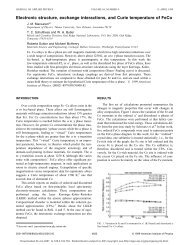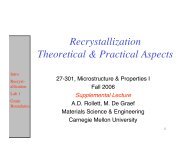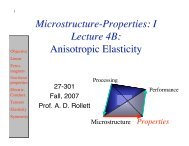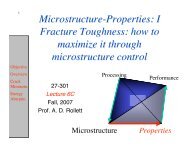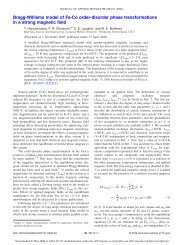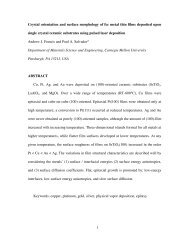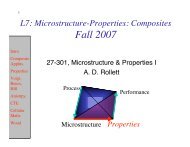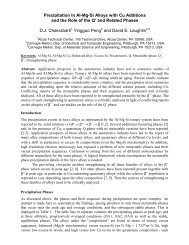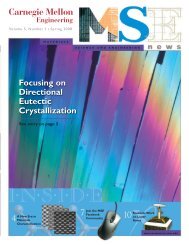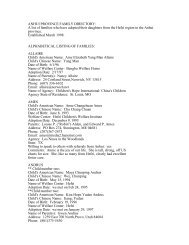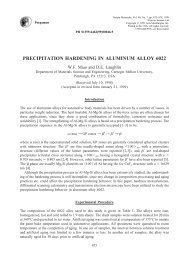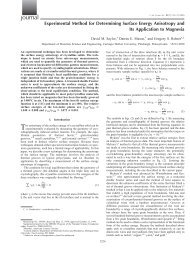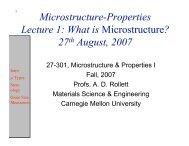popLA Manual (PDF) - Materials Science and Engineering
popLA Manual (PDF) - Materials Science and Engineering
popLA Manual (PDF) - Materials Science and Engineering
You also want an ePaper? Increase the reach of your titles
YUMPU automatically turns print PDFs into web optimized ePapers that Google loves.
PROPERTIES (page 7)<br />
Properties (<strong>popLA</strong> page 7)<br />
0. Quit<br />
1. Return to page one<br />
2. Assign Weights to discrete grains file from .SOD<br />
(Need Kocks style Euler angles in both .SOD <strong>and</strong> TEXfilecan<br />
convert the latter in DIOR, p.5,7)<br />
3. Average elastic properties (Reuss, Voigt, Hill, self-consistent)<br />
(Program by C. Tome) Input ELTEX.DAT, ELMOD.DAT; out ELOUT?.DAT<br />
4. Simulation of polycrystal plasticity from weighted grain file -<br />
LApp code: with rate sensitivity <strong>and</strong> grain shape effects,<br />
for all crystal <strong>and</strong> sample symmetries,<br />
calculate current yield surface, Lankford coefficients;<br />
predict texture development, Taylor factors,<br />
stress/strain curves for all straining paths.<br />
SHEET properties directly from harmonic coefficients<br />
(orthotropic plane strain cubic metals)<br />
5. Yield locus section (11,22) for any angle in plane (Bishop-Hill)<br />
6. Lankford coefficients (Hosford-Backofen model)<br />
Please enter a number from 0 to 6 --><br />
#0 Quit<br />
This option quits <strong>popLA</strong> <strong>and</strong> returns to DOS.<br />
#1 Return to Page One<br />
Selecting this option returns you to the main menu of <strong>popLA</strong><br />
#2 Assign Weights To Discrete Grains File<br />
This option creates a .WTS file from a .SOD file.<br />
<strong>popLA</strong> first lists the available weights files that can be used as inputs, <strong>and</strong> the conditions for which they<br />
apply. The output file has the weights of the input file multiplied with the density in the appropriate box in the<br />
.SOD; it assumes the specname of the .SOD, with the extension .WTS.<br />
A detailed description is given in the TUTORIAL section of this manual. The following displays the screen<br />
interaction, with some sample answers.<br />
* Intensity file (w/ext: .SOP or . S?D, default =.SOD: TRY<br />
* Enter the name of the [\dir\] grains file: TEXCUB.WTS<br />
* Discard grains below a certain weight? 0.25<br />
* Is this a file of triplets to be averaged ? 1<br />
* How many orientations total? 768<br />
* Do you wish to bring grains from outside the irreducible area into<br />
it, by applying 360/PHI Max.-fold crystals z-axis? (Use 0 with<br />
TEXLAT.WTS, TEXIS0.WTS,TEXCUB.WTS)--> 0<br />
#3 Elastic Properties<br />
This routine by C. Tomé calculates the Voigt <strong>and</strong> Reuss bounds on the elastic constants of the textured<br />
polycrystal, given an input texture <strong>and</strong> the single crystal elastic constants. It will also estimate the polycrystal<br />
elastic constants using the Hill average <strong>and</strong> a self-consistent method.<br />
You need two input files:<br />
• ELMOD.DAT, which contains the single-crystal properties. Use the sample provided <strong>and</strong> edit it. There are<br />
also other options appended, which can be moved to the appropriate place.<br />
• ELTEX.DAT, which is a st<strong>and</strong>ard .WTS file (in any Euler angles) except that the grain aspect ratios are<br />
(currently) not calculated from F in the 3rd line, but need to be explicitly given as 3 number in this line.<br />
When the first number is 0.0 (as usual for Evm in initial files), all aspect rations are assumed 1.0.<br />
The output file ELOUT1.DAT contain all the various polycrystal moduli (labeled).<br />
#4 Simulation of Polycrystal Plasticity<br />
This option displays only rudimentary instructions on how to use LApp, a polycrystal plasticity code based on the<br />
Taylor model. This routine requires the texture be represented by a set of weighted discrete orientations (.WTS<br />
file). Further instructions can be found at the end of this manual.<br />
DETAILS 34



